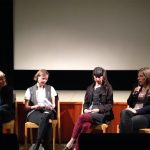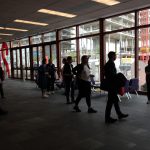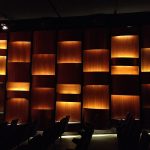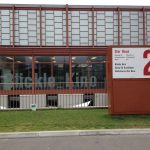7th June 2017
Blickle Kino / 21er Haus, Museum für zeitgenössische Kunst, Vienna
The SCCA’s widespread video archive networking practices, this year resulted in DIVA Station archive presentation and video screening in Kino Blickle in Vienna. The event was organized by Ursula Blickle Video Archiv, active since 2007 with a particular focus on Austrian video art from the 1990s and 2000s.
After the screening of 16 art videos from the program DIVA Station Presents 4, a brief discussion took place with Barbara Borčić (curator, head of DIVA Station), Ana Čigon (artist) and Gerda Lampazler (artist, media theorist, co-head of Medienwerkstatt Wien). It mainly focused on the early emergence of video art in Austrian and Slovenian alternative scenes in the 1970s and 1980s, somehow connected through art festivals Trigon in Graz. The speakers also talked about various aspects of video art production and its connection to experimental film, fine arts and music, emphasising its distinctive features that differentiate video art from film industry. They emphasised the pride of video pioneers who called themselves video artist to distinguish themselves from film makers and succeeded to make a completely separate art scene in 1960s. Later, they also tackled the term of video art as a historic concept that is vis-à-vis a prevalent digital production, merging of film and video, destined to become obsolete.
Claudia Slanar, the curator of the Ursula Blickle Video Archive, who brought attention to the strong interrelation between Slovenian television and video production, moderated the discussion.
Earlier that day, we (DIVA Station team) visited Vienna’s most important contemporary art block, Museumsquartier. In the moment, all corners were conceptually charged with artistic expression of multidimensional cultural oppression and breaching of human rights.
Intriguing combination of international artists brought together visually gripping exhibition Conundrum of imagination (On the paradigm of exploration and discovery) inthe Leopold Museum. The exhibition presents retrospective views of colonization and slavery, its influence, legacy, as well as its continuation in a more subtle, elegant but ongoing inhuman practice.
Few meters away, in Kunsthalle Wien, in variety of styles and media works, thirty international artists were conceptually blended in the exhibition How to Live Together. Exploring the cultural effects of migration, also conditions and prospects of living together in terms of individual, political and social dimensions, exhibited works express collective appeal for traditional role models to be overcome, to make space for more empathy and tolerance for peaceful coexisting.
Further on, in MUMOK, the exhibition Woman (Feminist Avantgarde of the 1970s from the Sammlung Verbund Collection) showed a highly depicting feminist artistic stand against women’s oppression, dominate culture and media representation of female roles and expectations. 300 works by 48 artists from Europe and North and South America expressed female individual, social and sexual needs that have been neglected and suppressed. Although thematically quite different in comparison with the first two exhibitions and today still contemporary, it complemented to the idea of artistic reaction to injustice and search for equality.
Anita Budimir
More: The announcement of the event DIVA Station video archive on tour: Vienna
Production: SCCA-Ljubljana / Postaja DIVA, Slovenski kulturno informacijski center v Avstriji – SKICA, Ursula Blickle Video Archiv
Curator: Barbara Borčič
Video preparation: Neža Grum, Toni Poljanec, Peter Cerovšek
Web support: Vesna Bukovec




